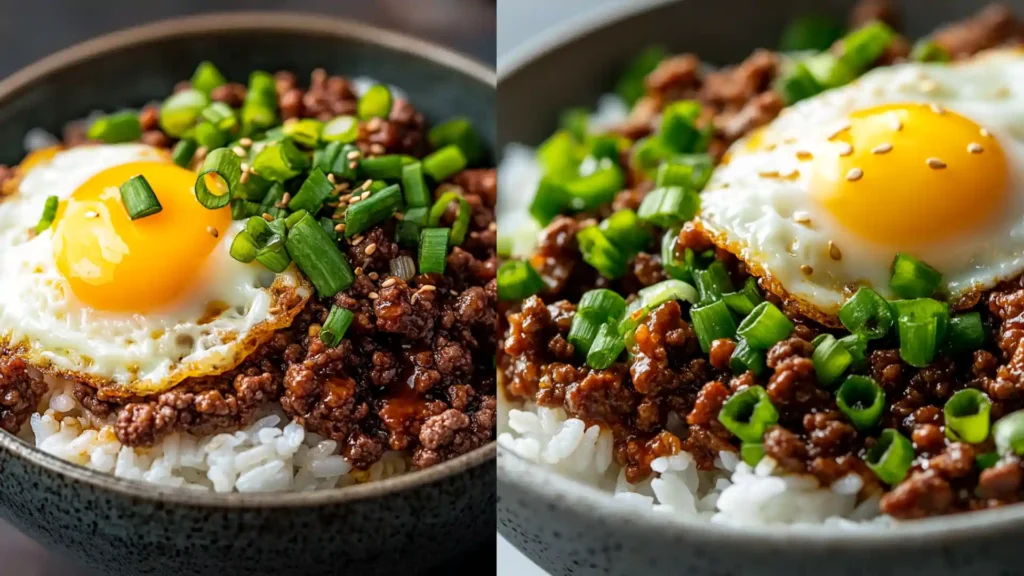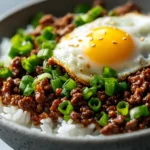Hey y’all! Paula here, and let me tell you, sometimes you just need a big ol’ hug in a bowl. That’s what this Korean Beef and Egg Bowl is for me. It’s got that savory, slightly sweet beef that just melts in your mouth, nestled with fluffy rice and a perfectly cooked egg. Whether you’re having a busy weeknight or just craving something comforting and packed with flavor, this bowl is a winner. It’s easier than you might think to whip up, and trust me, every bite is a little party in your mouth.
For those busy weeks when meal prep is key, you might also find our Ground Beef, Eggs, and Rice Meal Prep Boxes incredibly helpful. They offer the same great combo of beef, eggs, and rice, ready to go! And if you’re exploring other simple yet delicious ways to enjoy ground beef with rice, our collection of Easy Ground Beef and Rice Recipes has plenty more ideas that will hit the spot.
So grab your skillet, and let’s get cooking, darlings!

Table of Contents
Table of Contents
Why You’ll Love This Recipe
This Korean Beef and Egg Bowl isn’t just a meal; it’s an experience! Here’s why it’s about to become your new favorite:
- Explosion of Flavors: The combination of savory marinated beef, the richness of a runny egg yolk, and the subtle sweetness of the sauce creates a truly unforgettable taste.
- Quick and Easy: Perfect for busy weeknights, this recipe comes together surprisingly quickly without sacrificing flavor.
- Customizable: Feel free to adjust the spice level or add your favorite veggies to make it your own.
- Comfort Food Elevated: It’s the ultimate comfort food with an exciting international twist.
- Satisfying and Nutritious: Packed with protein, grains, and the option to add vegetables, it’s a well-rounded and satisfying meal.
Korean Beef and Egg Bowl
Equipment
- Skillet
- Frying pan for eggs
Ingredients
- 1 lb ground beef
- 2 tbsp soy sauce
- 1 tbsp brown sugar
- 1 tbsp sesame oil
- 1 tsp minced garlic
- 2 fried eggs
- 2 cups cooked white rice
- Optional: gochujang sesame seeds
Instructions
- Cook beef with soy sauce, sugar, garlic, and sesame oil.
- Fry eggs sunny-side-up.
- Plate rice, add beef and top with eggs.
Notes
Step-by-Step to Your Korean Beef and Egg Bowl
First, we’re going to get that beef bursting with flavor. You’ll want to take thinly sliced beef – the kind that cooks up quickly and stays tender – and let it soak in a marinade that’s a beautiful blend of savory, a touch of sweet, and maybe a hint of garlic and ginger. Give it some time to really absorb all those wonderful tastes.
Next up, let’s think about the foundation of our bowl: the rice. While the beef is marinating, get your rice cooking. Fluffy, perfectly cooked rice is the ideal bed for all the deliciousness that’s coming.
Once the beef has had its flavor bath, it’s time to bring it to the heat. A quick sauté in a skillet over medium-high heat is all it needs. You want it browned and cooked through but still nice and tender. The aroma at this stage is just incredible!
Now for that glorious egg. Whether you like it sunny-side up with a runny yolk that oozes into the rice, or perhaps a perfectly fried egg with a slightly firmer center, cook it just the way you love it. That golden yolk is going to add so much richness to our bowl.
Finally, the assembly! Take your warm, fluffy rice and spoon it into a bowl. Arrange that flavorful beef over the rice. And then, the star of the show – gently place your cooked egg right on top.
But we’re not quite done! A sprinkle of toasted sesame seeds adds a lovely nutty crunch. Maybe some thinly sliced green onions for a fresh, vibrant note. And if you like a little heat, a drizzle of your favorite chili sauce can take it to the next level.
There you have it – your very own Korean Beef and Egg Bowl, ready to be devoured!
Tips for Success
To make your Korean Beef and Egg Bowl absolutely perfect, here are a few handy tips:
- Don’t Overcook the Beef: For the most tender results, cook the thinly sliced beef quickly over medium-high heat. It should be browned but still juicy.
- Perfect Your Egg: Whether you prefer a runny yolk or a more set one, cook your egg to your liking. A fried egg with a soft yolk is classic for this dish.
- Taste and Adjust: Before serving, taste the beef and the sauce. Feel free to add more soy sauce, sugar, or gochujang to reach your preferred flavor profile.
- Use Fresh Rice: Freshly cooked rice makes a big difference in the overall texture and taste of the bowl.
- Garnish Wisely: A sprinkle of sesame seeds, chopped green onions, or a drizzle of sriracha can add visual appeal and extra flavor.
Variations
One of the great things about this bowl is how versatile it is! Here are a few ways you can switch things up:
- Spice it Up: Add a dollop of gochujang (Korean chili paste) to the beef marinade or as a topping for an extra kick. You could also sprinkle in some red pepper flakes.
- Veggie Power: Toss in some sautéed spinach, bean sprouts, shredded carrots, or kimchi for added nutrients and texture.
- Protein Swap: While beef is classic, you could also make this with ground chicken, pork, or even tofu for a vegetarian option.
- Different Egg Styles: Experiment with a poached egg, a soft-boiled egg, or even scrambled eggs instead of a fried egg.
- Flavor Boost: A dash of sesame oil in the rice or a sprinkle of toasted sesame seeds over the top can enhance the nutty flavors.
Serving Suggestions
This Korean Beef and Egg Bowl is fantastic on its own, but here are a few ideas to round out your meal:
- With Kimchi: The spicy, fermented cabbage is a classic Korean side dish that pairs perfectly with the savory beef and rice.
- Add a Side of Soup: A light miso soup or a clear vegetable broth would complement the richness of the bowl.
- Fresh Greens: A simple side salad with a light vinaigrette can add a refreshing element.
- More Veggies: Offer some steamed or stir-fried vegetables on the side, like broccoli or bok choy.
- Garnish Power: Don’t underestimate the impact of garnishes! A sprinkle of toasted sesame seeds, chopped green onions, or a drizzle of your favorite chili sauce can elevate the dish.
Meal Prep and Storage
This recipe is quite meal-prep friendly! Here’s how you can prepare and store the components:
- Beef: The marinated and cooked beef can be stored in an airtight container in the refrigerator for up to 3-4 days. Reheat it gently in a skillet or microwave.
- Rice: Cooked rice can also be stored in an airtight container in the refrigerator for up to 4 days. You can reheat it in the microwave with a splash of water to prevent it from drying out.
- Eggs: It’s best to cook the eggs fresh for each serving. However, if you need to prep ahead, you can hard-boil eggs and store them in the refrigerator for up to a week.
- Assembly: For the best quality, assemble the bowls just before serving. This prevents the rice from getting soggy. If you’re packing for lunch, keep the egg separate and add it right before eating, or opt for a hard-boiled egg.
Frequently Asked Questions (FAQ)
What is a Korean rice bowl called?
While there isn’t one single name for all Korean rice bowls, “bibimbap” is a popular and well-known type of Korean mixed rice bowl. Our Korean-Inspired Beef and Egg Bowl shares similarities with bibimbap in its layered structure and flavorful components.
What is usually in a Korean bowl?
Korean bowls often feature a base of rice topped with various seasoned vegetables, meat (like our delicious beef!), and often a fried or poached egg. They are known for their balance of flavors and textures.
Is bibimbap healthy?
Bibimbap can be a very healthy meal! It typically includes a variety of colorful vegetables, protein, and a serving of rice. The healthiness depends on the specific ingredients and the amount of sauce used. Our Korean-Inspired Beef and Egg Bowl can also be made healthy by including plenty of vegetables and lean beef.
What does Bulgogi mean?
“Bulgogi” literally translates to “fire meat” in Korean. It usually refers to thinly sliced, marinated beef or pork that is grilled or stir-fried, which is the style of beef we’re using in our bowl.
How do you eat a Korean rice bowl?
Korean rice bowls are typically meant to be mixed! Go ahead and stir everything together – the rice, beef, egg, and any other toppings – to enjoy all the flavors in each bite.
What is the difference between bibimbap and a Korean bowl?
“Korean bowl” is a broader term that can refer to any rice-based dish served in a bowl with toppings. Bibimbap is a specific type of Korean mixed rice bowl with characteristic ingredients like gochujang (chili pepper paste) and often a raw or fried egg. Our Korean-Inspired Beef and Egg Bowl takes inspiration from these concepts.
Conclusion
So there you have it, friends! Our Korean Beef and Egg Bowl – more than just a meal, it’s a delightful journey for your taste buds. The dance of the savory, slightly sweet marinated beef with the creamy richness of that perfectly cooked egg, all nestled on a bed of warm, fluffy rice, is truly something special. It’s the kind of dish that feels both comforting and exciting at the same time, perfect for those busy weeknights when you crave something delicious without the fuss.
What makes this bowl a winner is its beautiful simplicity and the way each component complements the others. Plus, as you’ve seen, it’s so easy to adapt to your own preferences and what you have on hand. Whether you decide to spice things up with a little gochujang, toss in some extra veggies for added crunch and nutrition, or experiment with different egg styles, this Korean Beef and Egg Bowl is your canvas.
We hope this step-by-step guide has inspired you to give this flavorful bowl a try. Trust us, the aroma alone as that beef sizzles in the pan is enough to make your mouth water! So gather your ingredients, get cooking, and get ready to enjoy a truly satisfying and delicious experience. Happy eating!


2 thoughts on “Korean Beef and Egg Bowl: A Flavor Fiesta in a Bowl!”